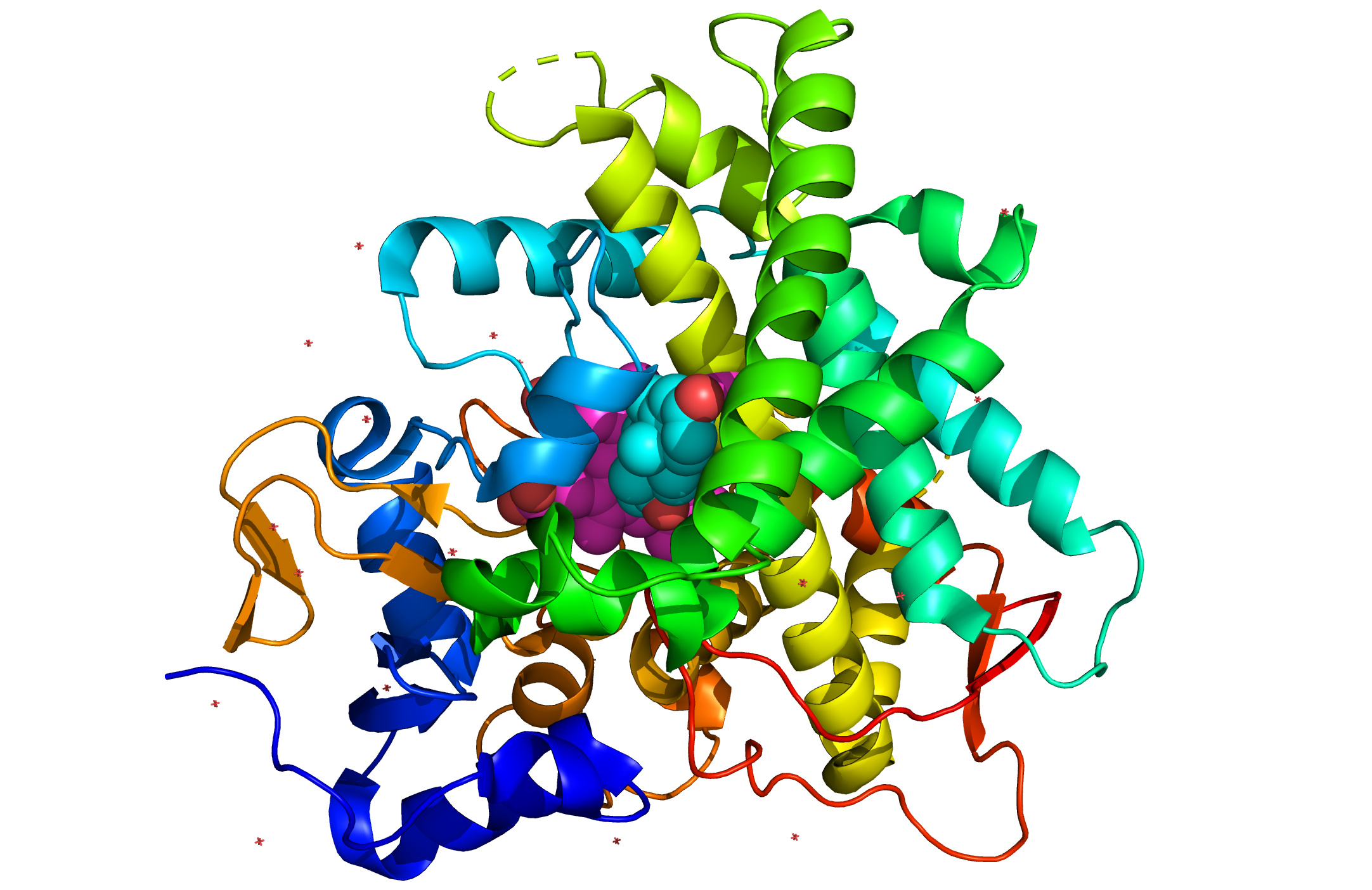Related Research Articles

Cytochromes P450 (CYPs) are a superfamily of enzymes containing heme as a cofactor that function as monooxygenases. In mammals, these proteins oxidize steroids, fatty acids, and xenobiotics, and are important for the clearance of various compounds, as well as for hormone synthesis and breakdown. In plants, these proteins are important for the biosynthesis of defensive compounds, fatty acids, and hormones.

Cytochrome P450 1B1 is an enzyme that in humans is encoded by the CYP1B1 gene.

Cytochrome P450 17A1, also called steroid 17α-monooxygenase, 17α-hydroxylase, 17,20-lyase, or 17,20-desmolase, is an enzyme of the hydroxylase type that in humans is encoded by the CYP17A1 gene on chromosome 10. It is ubiquitously expressed in many tissues and cell types, including the zona reticularis of the adrenal cortex and zona fasciculata as well as gonadal tissues. This gene encodes a member of the cytochrome P450 superfamily of enzymes. The cytochrome P450 proteins are generally regarded as monooxygenases that catalyze many reactions involved in drug metabolism and synthesis of cholesterol, steroids, and other lipids, including the remarkable carbon-carbon bond scission catalyzed by this enzyme. This protein localizes to the endoplasmic reticulum. It has both 17α-hydroxylase and 17,20-lyase activities, and is a key enzyme in the steroidogenic pathway that produces progestins, mineralocorticoids, glucocorticoids, androgens, and estrogens. More specifically, CYP17A1 acts upon pregnenolone and progesterone to add a hydroxyl (-OH) group at carbon 17 of the steroid D ring, or acts upon 17α-hydroxyprogesterone and 17α-hydroxypregnenolone to split the side-chain off the steroid nucleus. The CYP17A1 gene also contains one of 27 SNPs associated with increased risk of coronary artery disease.

Cholesterol side-chain cleavage enzyme is commonly referred to as P450scc, where "scc" is an acronym for side-chain cleavage. P450scc is a mitochondrial enzyme that catalyzes conversion of cholesterol to pregnenolone. This is the first reaction in the process of steroidogenesis in all mammalian tissues that specialize in the production of various steroid hormones.

Steroid 21-hydroxylase, also called steroid 21-monooxygenase, 21α-hydroxylase, P45021A2, and, less commonly, 21β-hydroxylase, is a cytochrome P450 enzyme that is involved with the biosynthesis of the steroid hormones aldosterone and cortisol. These syntheses take place in the adrenal cortex. Specifically, 21-hydroxylase converts progesterone and 17α-hydroxyprogesterone into 11-deoxycorticosterone and 11-deoxycortisol, respectively, by hydroxylating at the C21 position. The products of the conversions then continue through their appropriate pathways towards creation of aldosterone and cortisol.

Steroid 11β-hydroxylase is a steroid hydroxylase found in the zona glomerulosa and zona fasciculata. Named officially the cytochrome P450 11B1, mitochondrial, it is a protein that in humans is encoded by the CYP11B1 gene.

Cytochrome P450 3A5 is a protein that in humans is encoded by the CYP3A5 gene.

Cytochrome P450 2C18 is a protein that in humans is encoded by the CYP2C18 gene.

Cytochrome P450 4B1 is a protein that in humans is encoded by the CYP4B1 gene.

Cytochrome P450 3A43 is a protein that in humans is encoded by the CYP3A43 gene.

Cytochrome P450 2F1 is a protein that in humans is encoded by the CYP2F1 gene.

CYP27C1 is a protein that in humans is encoded by the CYP27C1 gene.

CYP26C1 is a protein which in humans is encoded by the CYP26C1gene.

CYP4X1 is a protein which in humans is encoded by the CYP4X1 gene.

CYP4A22 also known as fatty acid omega-hydroxylase is a protein which in humans is encoded by the CYP4A22 gene.

CYP2W1 is a protein that in humans is encoded by the CYP2W1 gene.

CYP2U1 is a protein that in humans is encoded by the CYP2U1 gene

CYP2A7 is a protein that in humans is encoded by the CYP2A7 gene.
1,8-Cineole 2-endo-monooxygenase (EC 1.14.13.156, P450cin, CYP176A, CYP176A1) is an enzyme with systematic name 1,8-cineole,NADPH:oxygen oxidoreductase (2-endo-hydroxylating). This enzyme catalyses the following chemical reaction
Putidaredoxin—NAD+ reductase (EC 1.18.1.5, putidaredoxin reductase, camA (gene)) is an enzyme with systematic name putidaredoxin:NAD+ oxidoreductase. This enzyme catalyses the following chemical reaction
References
- ↑ Poulos, Thomas L.; Finzel, Barry C.; Howard, Andrew J. (June 1987). "High-resolution crystal structure of cytochrome P450cam". Journal of Molecular Biology. 195 (3): 687–700. doi:10.1016/0022-2836(87)90190-2.
- ↑ Li, Shuying; Wackett, Lawrence P. (1993). "Reductive dehalogenation by cytochrome P450CAM: Substrate binding and catalysis". Biochemistry. 32 (36): 9355–9361. doi:10.1021/bi00087a014.